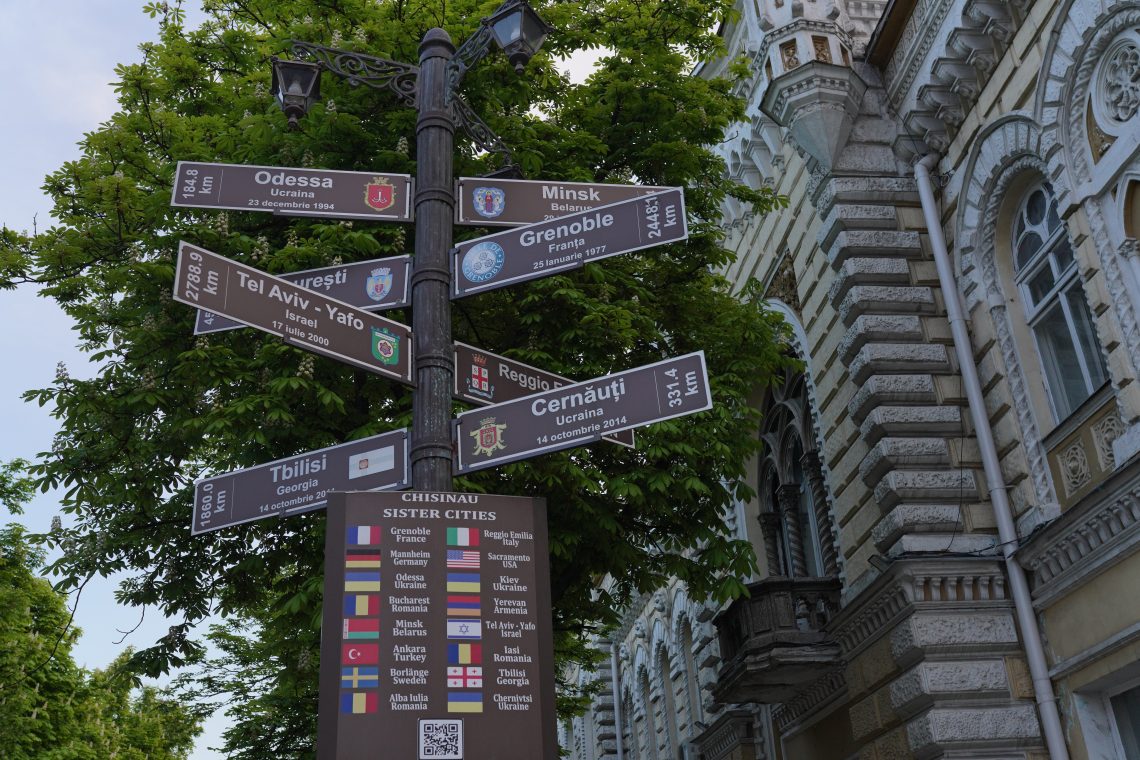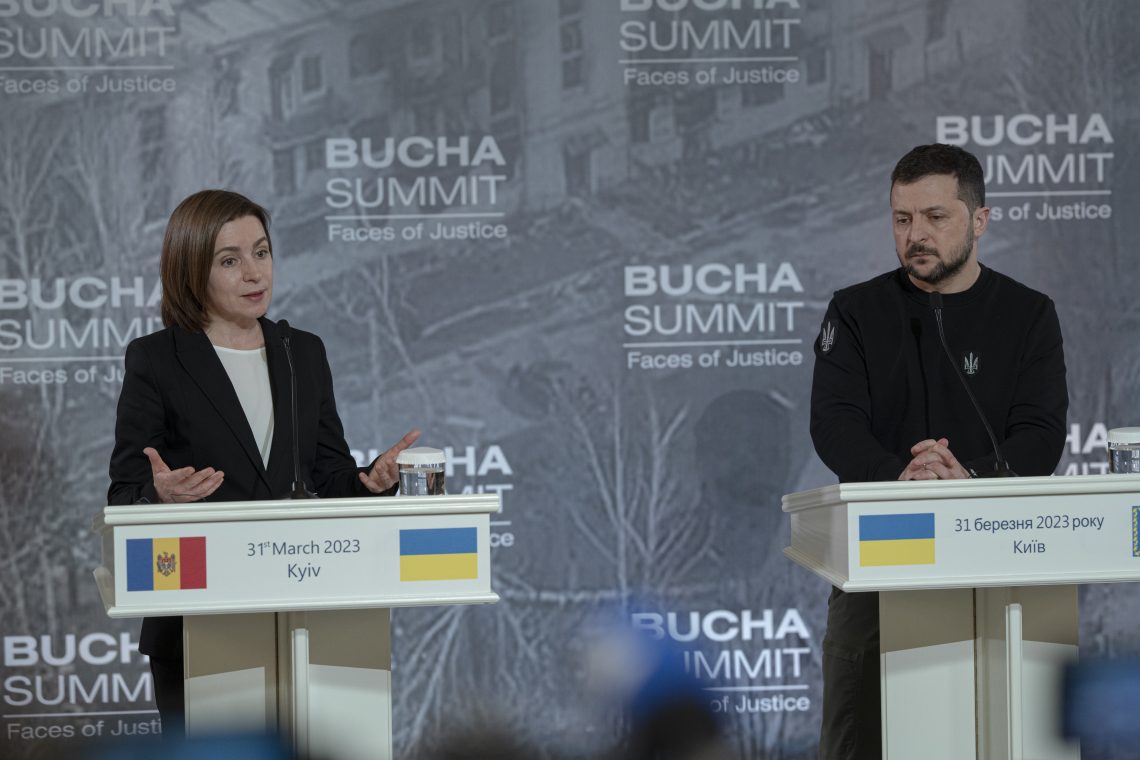Moldova’s escape from the East
Despite the war raging nearby, the most pressing risk to Moldova today is not a possible Russian invasion but internal instability.

In a nutshell
- Moldova has sought to attract more attention from Western and EU leaders
- Pro-Russian territories could become flash points in a crisis
- Efforts to join the EU must walk a political tightrope
“The most important thing is to maintain peace in the country,” says one prominent Moldovan politician, a seemingly sensible stand given Moldova’s front-row seat to war in Ukraine. Many Western politicians worry about an attack on Moldova from Transnistria, the narrow breakaway region backed by the Kremlin. However, the real problem may be internal destabilization and the hybrid threat from Russia.
The prospect of leveraging public unrest to replace the pro-European government in Chisinau is a preferred scenario for Moscow. As soon as a social issue emerges, like power outages from the war in Ukraine, Moldova’s pro-Western government becomes anxious. The fear is that something will spark a wave of protests leading to a change in power and a shift away from integration with the European Union and NATO.
The latest political crisis transpired in February 2023, when the pro-Western government of Natalia Gavrilita collapsed. Moldovan President Maia Sandu soon cited Ukrainian intelligence suggesting Russia was plotting a coup. These claims raised international concerns over a possible Russian tilt in Chisinau, particularly as the popularity of pro-Russian parties in the country has increased for several months. Anti-Western parties, including the SOR Party and the Electoral Bloc of Communists and Socialists (anchored by a postcommunist party dating back to the Soviet era), garner well over 30 percent support.
President Sandu used the crisis to bring the international spotlight on Moldova, which draws less attention from experts in Washington or Brussels than from South Caucasus states such as Armenia or Georgia. On February 16, the Moldovan parliament endorsed a pro-Western cabinet under the leadership of Prime Minister Dorin Recean, whose prior role as interior minister signaled that security matters were top of mind.
The United States soon used the opportunity of President Joe Biden’s visit to Poland and Ukraine to elevate the Moldova issue. Mr. Biden met with President Sandu in Warsaw, publicly declaring his support and later pledging financial assistance aimed at precluding any social unrest.
Road to the West
Moldova is the poorest country in Europe, with a lower gross domestic product (GDP) per capita than Albania and Kosovo. Only war-torn Ukraine now ranks below Moldova. The country lacks a significant industry or touristic appeal; its foreign trade is dominated by machinery and transport equipment, food, live animals and various industrial products. Contemporary Moldova strives to build a reputation for wine production, but so far, its main customers are limited to Romania and Poland, followed by Russia. Selling wine throughout the continent is a complex endeavor.
For Moldova, the only viable path is toward the EU and NATO. As a small country with limited resources, it can only secure prospects for development through broader integration. Its situation should be considered as part of a wider Central European scenario. Moldova joined the Eastern Partnership in 2009. After the Revolution of Dignity in Ukraine during 2013-2014, a window of opportunity opened for Moldova (along with Ukraine and Georgia) to sign agreements for cooperation with the EU. These included the Association Agreement, the Deep and Comprehensive Free Trade Area Agreement, and the Visa Facilitation Agreement. With Georgia and Ukraine, Moldova became part of the vanguard of former Soviet Union nations forming an informal “associated trio” with the EU. Another political door opened after Russia invaded Ukraine, and Moldova and Ukraine were granted EU candidate status in June 2022.
The leading figures spearheading the EU initiative in Moldova are President Maia Sandu and Nicolae “Nicu” Popescu, the government’s prime minister. The EU does not fundamentally object to Moldova’s admission; its market is relatively small, and its current political elite is well-received. Paradoxically, the most significant obstacle to admission will be logistical: establishing a team of professionals to facilitate the integration process. After years of economic emigration (often tragically tied to human trafficking), Moldova is depopulated and impoverished, with meager salaries for civil servants. The pool of civil servants available for aligning Moldovan law with EU law is tiny. For example, only about 10 people work directly with Prime Minister Popescu on integration issues.

Expert advice is being provided by professionals hired by international institutions, particularly the EU. The composition of this team reflects the modest level of interest in Moldova within Europe. The largest group consists of Romanians. Given that a significant portion of Moldovan citizens support the possibility of unification with Romania (approximately 40 percent are in favor of a union with Romania, with 40 percent against), the presence of these Romanians advising key Moldovan politicians is understandable, albeit potentially controversial. Moreover, Romanian politicians, such as former Prime Minister Ludovic Orban (2019-2020), have made statements suggesting a future unification with Romania. Such a mindset may lead to aggravated regional consequences like those already caused by Hungarian Prime Minister Viktor Orban’s revisionist tendencies. Any internationally sanctioned border change would be a boon to President Orban’s fixation on rolling back the territorial effects of the post-World War I Treaty of Trianon.
Moldova’s predicament is that few EU countries are seriously interested in its welfare and interests, leaving Romanian support with few alternatives. Of course, some countries, such as Lithuania, recognize the strategic importance of safeguarding against Russian influence in the southeast and the Black Sea region. The second most engaged country is Poland. Working for the Moldovan government are several notable Polish individuals, including the former head of the Central Anticorruption Bureau, Pawel Wojtunik; an experienced Polish diplomat who also managed the EU’s diplomatic missions, Jan Tombinski; and the former chair of the Foreign Affairs Committee of the Polish Sejm, Krzysztof Lisek, who in turn heads the influential Moldovan office of the International Republican Institute (IRI).
A highly effective way of promoting the European agenda in Moldova involves aid activities executed by Polish government institutions targeting local governments in Moldova. No other country today has such a substantial involvement in development and assistance in implementing reforms. Poland does not have many direct interests in Moldova, and cannot be reasonably accused of a hidden agenda, hence Warsaw’s good standing in the milieu of Moldova’s pro-European government.
Modernization
In the face of Russia’s attack on Ukraine, Moldova is becoming a proving ground for modernization, a path that runs through the EU and cooperation with NATO. Moldova’s success will be intertwined with the war front. However, successful changes will also provide guidance for several other EU candidates from the South Caucasus and the Western Balkans. Moldova is having its moment in history. Despite their political affiliations, 65 percent of the population supports such a vision, while 15 percent are against it.
The upcoming summit of the European Political Community countries in Chisinau is set to confirm that the Moldovan elite grasps the significance of this moment. Moldova’s pro-European government is keen to seize such opportunities. (Notably, the situation in the country is now such that the summit will take place without foreign leaders staying overnight on site, for security considerations and otherwise.)
Moldova’s cooperation with the West following Russia’s February 2022 invasion has proven effective in several ways. Firstly, Moldova was the initial target of the Kremlin’s energy blackmail but emerged unscathed. With logistical, technical and financial support from the West, it attained independence from Russian gas for the first time in its history.
Secondly, Europe’s poorest country has accepted the highest per capita number of war refugees and effectively supported them, enrolling children in schools, providing jobs and establishing communication between the airport in Chisinau and southern Ukraine. Over the past few months, Moldova has established closer ties with Western security structures and initiated a swift reform of its army. This process is expected to take about 15 years.
Facts & figures
A few years ago, discussing the need to join NATO would have been unthinkable in Moldova. The principle of state neutrality, originating from the post-Soviet era, was broadly accepted. Currently, Prime Minister Popescu is publicly expressing his willingness to join the military alliance. Depending on the specific structures included, Moldova has up to 15,000 troops. Military officials noted that about 60 percent of senior military personnel have had exposure to Western-style military training. A big problem will be carrying out purchases for the army in the coming years, as placing small orders and finding contractors can be a harder task than, for example, operating on a larger scale. Despite substantial positive changes in the army’s functioning, Moldova is currently incapable of effectively defending its own territory, and will likely remain so after the army’s modernization.
Flash points
Theoretically, the most significant threat to Moldova could be a military attack from Russian forces stationed in Transnistria. It was plausible that an attempt to cross the Dniester River and swiftly seize Chisinau could have been launched immediately after February 24, 2022, using the element of surprise. While precise figures are difficult to come by, some 18,000 Russian troops may be now in Transnistria, with locals making up half of this number. Indeed, Russia exercises considerable control over a significant portion of Transnistria’s government and administration. However, the inhabitants of Transnistria primarily depend on trade with the EU.
Transnistria is today under the influence of Russian special services, with elements likely connected to mafia structures. The enclave finds it challenging to ensure security. But if Moldova joins the EU and Ukraine does not lose the war, the issue of future integration with the breakaway region could be solved through facts on the ground rather than complex negotiations involving Russia.
Russian propaganda absurdly claims that Ukraine is interested in occupying Transnistria and annexing this territory. In reality, if Moldova’s European experiment succeeded, the people of Transnistria may be the first to see that full state integration aligns with their interests.
Paradoxically, a more acute problem might be the situation in Gagauzia, a tiny autonomous territorial unit in southern Moldova. An integral part of the country, it is nevertheless dominated by pro-Russian forces. The top two slots in the territory’s recent elections were taken by pro-Russian candidates. According to IRI data, support for joining the EU in Gagauzia is 5 percent, and for NATO, 1 percent. Statistically, Gagauzia may not play a significant role, but it could become a potential flash point during a crisis.
Scenarios
In principle, the Moldovan scenario – like others in Eastern Europe, the South Caucasus and Central Asia – will largely be determined by the developments on the Ukrainian battlefield. If Russia fails to win, its reputation within its former imperial spheres of influence will dwindle. Conversely, if Russia manages to regain momentum, regional supporters will be emboldened. Meanwhile, countries like Moldova can restructure their strategic positions; Russia is preoccupied, and its post-Soviet influence is being fundamentally questioned.
A positive scenario for Moldova would entail a decision to begin negotiations with the EU in 2023. Among Ukraine’s two smaller partners in Eastern Europe on their journey toward the union, Moldova is currently considered the reliable partner with strong proponents – unlike Georgia. Therefore, President Sandu and the Moldovan government are keen on maintaining good relations with Ukraine and are hopeful for a similar pace of integration. Ultimately, Moldova’s negotiations may proceed more swiftly due to the country’s smaller size.
There is no doubt that Romania would perceive Moldova’s integration with the EU as an alternative to Moldova’s integration with Romania; Moldova inside the EU will inevitably be closer to Romania than otherwise. Success depends on fast-track negotiations and adequate protection against any Russian attempts to carry out a hybrid operation against Moldova.
Another factor is the question of support for Moldova’s integration process by a team of external advisors from countries other than Romania and Poland. The critical element is the swift development of a local bureaucratic force that will take charge of the integration process, involving several hundred qualified, well-paid officials. A successful integration pathway for Moldova might also encourage pro-European enthusiasm in Western Balkan countries, already awaiting their turn to join the EU. In such a scenario, Moldova has a real chance of becoming a stable and safe investment market within a decade, boasting a small but competitive labor market, young talent and other assets.
Prolonging the EU integration process would structurally weaken the Moldovan government and erode its base of support. If signals from Ukraine turn negative, that could boost the pro-Russian forces in Moldova waiting for an opportunity to play the anti-Western card.
If Moldova’s current government collapses, the idea of the country’s effective integration with the West may need to be abandoned for a long time. At stake in Chisinau is not only the reputation of pro-Western Moldovan politicians, but also that of the many Western governments – like Romania and Poland, the EU and the U.S. – promoting this direction. A Western retreat also would entail increased threats from Transnistria and a rise in separatist sentiments in Gagauzia.
Moldova’s biggest challenge is that there is no “middle ground” scenario. The process decided by the government and its Western allies, which has a slim majority approval in society and an even shakier one in parliament, hinges on the assumption that voters will quickly appreciate this policy in the next elections. If Moldova does not rapidly shed its economic dependence on Russia, for example, the political operation may fail. If Ukraine does not lose, the problem for Moldova will not be Transnistria or a Russian military attack but the collapse of public faith in a path to the West.










